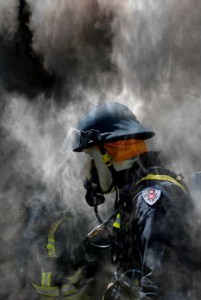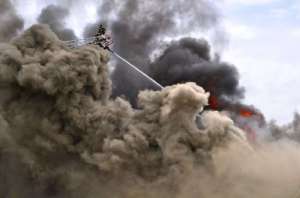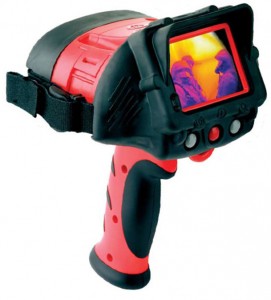
Smoke Signals
Guest Post
by John Kenny
The theatre manager told us we would have to leave if we couldn’t be quiet. A group of fellow firefighters and I were howling with laughter as we watched “Backdraft”. Kurt Russell was dashing through a blazing inferno, coat open, boots rolled down and with no breathing apparatus.
Even the rawest recruit knew that in real life Russell would be dead two steps in. What was missing was the single deadliest thing in a fire – smoke. Hollywood leaves out the smoke, or at best shows a light mist, because if they showed what it was really like all you would see would be a black screen. At best you’d see an orange glow as the camera got close to the fire.
Smoke is the product of incomplete combustion due an inadequate supply of fresh air (oxygen). This is exactly what happens inside a tightly closed home or other structure. Furthermore the smoke has nowhere to go. Sitting around a campfire the smoke simply rises and blows away. Anyone who’s had the smoke blow in their direction knows how uncomfortable that is – the coughing and stinging eyes. You can imagine what it’s like inside a building: even if you could keep your eyes open in that stinging murk, the smoke rapidly builds up until you literally can’t see the hand in front of your face.
That’s the first deadly thing about smoke, it obscures the exits and causes disorientation. Even inside their own home, most people have trouble finding the door. Then the smoke kills by a combination of suffocation (because the fire is consuming all the oxygen), poisoning (smoke contains carbon monoxide, cyanide and dozens of other toxic chemicals) and thermal damage to the lung tissue (yup, it’s hot inside a burning building). The vast majority of fire victims, about 75% die from smoke inhalation.

Firefighters wear what’s called an SCBA -Self Contained Breathing Apparatus. It’s the single most important piece of gear. Without it they couldn’t operate inside a fire. The tank worn on the back supplies compressed fresh air, not oxygen, to the face piece. The SCBA is also fitted with a variety of sensors, monitors and alarms. The most important of these is the motion sensor. It goes into alarm if the firefighter stops moving, i.e. he or she has become trapped or unconscious.
The SCBA however, does nothing for vision. As a firefighter, that blindness is scariest and most challenging thing in a fire. You feel your way along walls, tripping over unseen obstacles, groping for doorways, hoping you don’t fall through a hole or down a flight of stairs.

Hand held thermal imaging cameras can help. They operate using infrared radiation which penetrates smoke much better than visible light. Thermal imaging cameras are great for locating victims, finding the seat of a fire and detecting hot spots inside walls and ceilings. The drawback is that it ties up at least one hand.
There have been experiments with helmet and face piece mounted thermal imaging cameras, but so far they have not been widely adopted. The first problem is weight. Protecting the camera from fire and water means a fairly large and bulky housing. The second factor is cost – several thousand dollars per firefighter. Hopefully, as with other electronics, the size and cost of these units will come down.
In the meantime we crawl. Crawling allows firefighters to sweep their hands in front of them feeling for bodies or hazards. The visibility is sometimes marginally better close to the floor. And it’s a lot cooler. There can be several hundred degrees difference in the temperature between standing and crawling.
Smoke will also give a lot of information about a fire, if you know how to read it. The colour, density and behaviour of the smoke will indicate what’s burning, how much air the fire is getting and what it’s likely to do next. A sommelier will describe the aroma of pear, citrus notes and hints of vanilla. It all smells like wine to me, but an experienced firefighter can distinguish between the smell of burnt food, garbage, paper, drywall, wood, plastic, electronics and several more.
The darker the smoke is the less air the fire is getting and the more flammable the smoke is. That’s what smoke is – unburnt fuel. A dense brownish-yellow colour indicates the presence of highly flammable oil and tar particles. A new supply of fresh air, by breaking a window or suddenly opening a door can result in a backdraft explosion. The explosion is less violent than a high explosive like dynamite, but it is deadly to anyone caught in its path. These events are very rare.
More common and just as deadly is what is called a flashover. This happens when the temperature inside a structure reaches about 550° C (1000° F). At that point everything in the room, contents, furnishings, wallpaper, rugs, everything simultaneously bursts into flame. A good indication a flashover is about to occur is the presence of “angel fingers”, tongues of flame running along the ceiling through heavy black smoke.
The black colour comes mostly from soot, tiny particles of carbon. You can think of them as billions of microscopic bits of charcoal. In addition smoke contains flammable gases such as acetylene, benzene and hundreds of other complex hydrocarbons. Many of these are carcinogenic and are absorbed directly through the skin. Ironically fire retardants containing chlorine and bromine produce some of the most carcinogenic smoke. This leads the high rate of cancer among firefighters, about double the normal population.
When the smoke takes on rainbow hues of orange, green or purple firefighters really start to worry. Those colours are an indication of the presence highly toxic and dangerous chemicals. They’re normally seen at industrial fires, but can also be seen at fires involving illegal clandestine drug labs, or even in basement and garage fires if things such as fertilizers, pesticides, paint and solvents are stored inside.
The movement of smoke, particularly in large buildings and high rises is a complex science, involving pressure and temperature gradients. In general where ever the smoke goes the fire will soon follow. This is why fire doors and dampers and other controls on ventilation ducts are so important. You don’t want toxic smoke or the fire it precedes to travel freely through the building.
Learning to read smoke is an essential skill for firefighters. I’m still learning its subtleties after 25 years. If you’re planning a fire scene in your novel, pay a visit to your local fire station. The men and women there will be only too glad to share their experience and give advice about your scenario.
Above all don’t forget the smoke.
John Kenny has been a firefighter since 1989. It was perhaps karma, having accidentally set fire to his parents’ house when he was seventeen. His family is grateful that John that he has not tried to cook homemade french fries since. John lives outside Ottawa, Canada with his wife Liz and their fur children. The Spark is his first novel. When not running into burning buildings he is an avid sailor, enthusiastic traveler and a mediocre hockey player. Learn more about John at his website and his Author Central page.

Thanks for this. Great to hear this kind of stuff from an expert!
You’re welcome. Writers generally do a better job than film or television. Emotionally fires are very intense, but visually their pretty dull. At least from the inside
Handy advice. And a fascinating piece in its own right!
Glad you found it both useful and interesting.
Thanks for this. I have bookmarked it for future reference. My last book was about a firefighter (Zero Hero). He is only in one fire, at the very beginning of the book. I think I got it right. There was lots of smoke and he couldn’t see anything.
If you got smoke, heat and some urgency, you got it right.
Yup. I’ve got all three of those. Thanks, John!
I want to commend you on your bravery, and selflessness. I don’t think fireman/woman are given their just due. Reading the above post provided a look into a frightening world, or at least frightening to me. Thank you for a picture I’ll never forget, and information I hope I never have to use(except in a book).
Shucks ma’am, t’weren’t nothin’. Actually we do get a lot of positive feedback – at least up here in Canada. As for the fear part, well sane people don’t run into burning buildings. On the other hand, I don’t want anyone on my crew who isn’t a little afraid going into a fire. That’s sensible caution. Anyone without that isn’t brave – they’re foolish. The key is managing the fear, trusting your experience and training, because the other extreme – panic, is just as deadly.
Very interesting read. Thank you. And I agree, firefighters don’t get the approbation they REALLY deserve. Cheers.
Thanks JD. As I said above, we do get our fair share of credit, unlike our police and paramedic colleagues. (You couldn’t pay me enough to be a Cop). And we get to help people in desperate situations. Believe me, there is NOTHING that feels better than putting a kid back in their parents arms. You can’t buy that feeling.
Thanks for this great article–I am most definitely bookmarking for future reference. Loved your description of ‘angel fingers’–gave me a right chill…
You’re welcome :). Angel fingers give me more than a chill. They give me that extreme sphincter tightening, it’s time to get the hell out of Dodge feeling! 😉
John, great post, excellent information. We all know Hollywood glosses over things like this to ramp up the visual appeal, but we writers (most of us, anyway) want authenticity, and this is it. I just released a book that had arson in it, and I realize after reading yours that I could have used more smoke. Oh, well; next time! Thanks for posting.
Not to worry. Some literary license is understandable. What ever drives the story ahead and is credible.
VERY interesting. Thanks. And kudos to you and your men.
Make that your crew.
Yup, it’s been my pleasure to work with some of toughest women you’ll ever meet. That’s a good thing.
Great article – absolutely fascinating.
Years ago I was on a team building exercise where we spent time in a (safe) smoke filled room with breathing masks on. The disorientation is amazing – I would have sworn the room was huge with a really complex layout. When they cleared the smoke and we went back in it was amazing just how small the room was and simple the layout was.
I guess this also backs up the importance of smoke alarms – they not only wake you up before the smoke overcomes you, (I think) they give you a chance to get out before the smoke becomes too thick.
Smoke alarms are simply the cheapest life insurance you’ll ever buy. In 25 years as a firefighter I have NEVER been to a fatality if there was WORKING smoke detector. It’s just so very, very sad when we find a body lying under a smoke detector with a dead battery or one that’s been removed.
Thanks for a great article, John. If I ever write a fire scene, I’ll be relying on your descriptions — as I have absolutely no desire to collect first-hand experience of my own. 🙂
Thanks Lynne. Ya, some research you don’t need to collect first hand. As I’ve said many times, sane people don’t run into burning buildings. And your local fire department is a great resource if you have any questions.
Thank you for sharing, it is a great post. Great to have such detail about smoke for our next fiery scene. My grandfather was the chief of a volunteer fire department years ago. One fire he lost his eye, but he never complained. Fire fighters are brave, and you are generous for sharing your knowledge with us.
I have the deepest admiration for volunteer firefighters. At least I get a good salary and medical benefits. The volunteers… well that is true altruism.
Thanks for the expert and interesting information, John. Brought to mind the following experience: I had just moved into the St. George Tower in Brooklyn Heights when the neighboring building caught fire – and wow! it was something else – the towering inferno – perhaps the worst urban fire in decades, someone said. Our maintenance went up up up after that….oops, forgot to say i had been cooking for my housewarming party and was so whacked out i slept through all the alarms — the way i knew something weird was going on was to see a fireman perched on a ladder outside my 6th floor window — a very handsome fireman by the way — you guys are amazing!
High rise fires are particularly difficult and complex to manage – difficulty evacuating large numbers of people, problems getting enough firefighters and equipment to upper floors, smoke migration…
Some of guys are handsome. Unfortunately for me they have a rule against pencil necked geeks being in the calendar. But the money raised always goes to a good cause.
Talk about serendipty! I just finished The Spark last night. 😀
I bought The Spark because my mind has been focused on bushfires for the last three months, but I couldn’t put it down because of the story and characters. Truly fantastic debut novel, John. Congratulations, and thanks for this great post as well. Will be reblogging it tomorrow.
Thanks. Loved your blog too. Glad the bush fires are winding down. I know from my time in Oz just how devastating they can be. Hope you weren’t too badly affected.
We had a couple of close calls but my immediate area remained safe, for another year. If this dry weather continues though, next year could be fun. As an honorary aussie, please drop in any time. 🙂
Right on the money, John. I’m always saying, about anything you’re writing, “If you don’t have personal experience, ask an expert!”
And firefighters are always eager to talk about their experience. Some of the story might even be true.